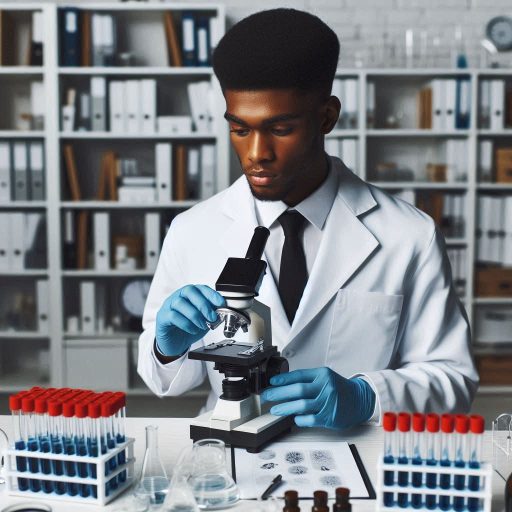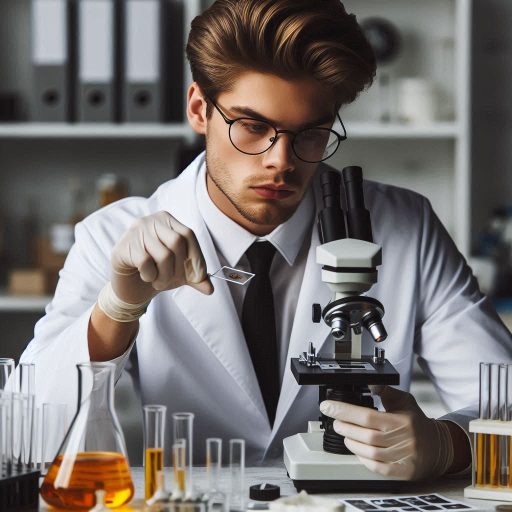Introduction
Forensic science plays a crucial role in solving crimes.
It combines various scientific disciplines to analyze evidence from crime scenes.
By applying techniques from biology, chemistry, and physics, forensic scientists help law enforcement agencies bring criminals to justice.
The term “forensic science” refers to the application of scientific methods in legal contexts.
It encompasses various fields, including forensic biology, toxicology, and fingerprint analysis.
Each discipline contributes unique insights that can prove vital in criminal investigations.
For example, DNA analysis can link a suspect to a crime scene, while ballistics can identify firearms used in a shooting.
Forensic science enhances the reliability of evidence presented in court.
It allows juries to evaluate the validity of claims made by prosecutors and defense attorneys.
The use of scientific evidence also increases public confidence in the justice system.
When people see that cases are solved through rigorous scientific methods, they feel assured that justice is served.
Famous cases demonstrate the power of forensic science in action.
One such case is the O.J. Simpson trial, where DNA evidence played a significant role in the proceedings.
Similarly, the capture of the Golden State Killer relied on genetic genealogy techniques that analyzed distant relatives‘ DNA.
Case 1: The O.J. Simpson Trial
Overview of the Case and the Evidence That Pointed to Simpson’s Guilt
The O.J. Simpson trial remains one of the most famous criminal cases in U.S. history.
It began on June 12, 1994, when Nicole Brown Simpson and Ron Goldman were murdered outside Brown’s home in Los Angeles.
O.J. Simpson, a former football star, quickly became the primary suspect.
The evidence against him was overwhelming, including blood samples, a bloody glove, and DNA evidence.
Crime scene investigators collected various pieces of evidence.
They found blood at the crime scene belonging to both victims and Simpson.
A bloody glove discovered at Simpson’s estate matched one found at the murder scene.
This glove provided a strong link between Simpson and the murders.
How DNA Analysis Played a Crucial Role in Convicting Simpson
DNA analysis played a crucial role in this case.
Forensic scientists used groundbreaking techniques to analyze blood samples.
They compared the DNA found at the scene with Simpson’s blood.
The analysis showed a match, which raised serious questions about Simpson’s innocence.
DNA evidence provided a clear scientific connection between him and the crime.
Impact of This Case on the Use of Forensic Evidence in Courtrooms
This trial marked a turning point for forensic science in courtrooms.
The prosecution’s reliance on DNA evidence set new standards for criminal cases.
It highlighted the importance of forensic science in solving crimes.
Prior to this case, many people were skeptical of forensic evidence.
Simpson’s trial changed that perception dramatically.
The case also raised questions about the reliability of forensic evidence.
Some argued that contamination could occur during evidence collection.
Defense attorneys challenged the handling of the evidence and the credibility of forensic experts.
This trial introduced the concept of ‘forensic science‘ to the public.
People began to understand the role it plays in criminal justice.
As a result of this case, courts began to evaluate forensic evidence more carefully.
Legal professionals realized the importance of using scientifically validated methods.
The Simpson trial encouraged the development of stricter standards for forensic evidence.
Judges and juries became more aware of the science behind the evidence presented.
Today, the O.J. Simpson trial remains a benchmark for forensic science in criminal law.
It demonstrates the power and potential of DNA analysis in court.
This case not only impacted Simpson’s life but also changed the legal landscape.
Forensic scientists now play a vital role in solving crimes and securing convictions.
The O.J. Simpson trial serves as a reminder of how science can shape justice.
Read: U.S. Cities with the Most Opportunities for Environmental Scientists
Case 2: The JonBen‘t Ramsey Murder
The Crime and the Initial Investigation
The murder of JonBen‘t Ramsey, a six-year-old beauty queen, shocked the nation in December 1996.
Her body was discovered in the basement of her family‘s Boulder, Colorado home on December 26.
Authorities initially treated the case as a kidnapping, following a ransom note found in the house.
The note demanded $118,000 for JonBen‘t’s safe return, creating a sensational narrative.
However, the investigation quickly shifted focus after her body was found.
The initial investigation faced significant challenges.
Police and investigators failed to secure the crime scene, allowing many individuals to enter the house.
This mishandling led to the contamination of potential evidence.
Forensic experts arrived later to analyze the scene but encountered various obstacles.
The lack of a secure perimeter and a controlled investigation hampered their efforts.
Description of the Forensic Evidence That Eventually Led to the Arrest of a Suspect
Forensic evidence emerged as a key component in unraveling this mystery.
Investigators collected hair samples, fingerprints, and biological material from the scene.
Notably, they discovered a small amount of pineapple in JonBen‘t‘s stomach, leading to questions about her last hours.
A foreign DNA sample, found on JonBen‘t‘s underwear, became a pivotal piece of evidence.
Despite extensive analysis, the identity of the DNA profile remained unknown for years.
In 2006, forensic advancements reignited interest in the case.
Investigators used advanced DNA testing techniques to re-examine the collected samples.
These tests indicated that the DNA found did not match any of the Ramsey family members.
This discovery shifted the focus to potential intruders, reopening the investigation to new suspects.
However, no conclusive arrests were made at that time.
Controversies Surrounding the Case and the Role of Forensic Experts in Solving It
Controversies surrounding the JonBen‘t Ramsey case persist.
Many questioned the actions of the Boulder Police Department during the investigation.
Critics argue that the initial response compromised evidence, clouding the investigation‘s integrity.
Furthermore, the media‘s intense scrutiny created a circus-like atmosphere that complicated the search for justice.
Forensic experts faced pressure to provide quick answers amidst public demand for resolution.
The role of forensic scientists became crucial in navigating these controversies.
They faced skepticism from the public and media, who demanded clear explanations.
However, their work highlighted the complexity of forensic evidence and the need for meticulous analysis.
Forensic experts continuously sought to understand the case through scientific methods and advanced technology.
Their contributions aimed to bring closure to the Ramsey family and justice for JonBen‘t.
As new developments unfold, the case remains a poignant reminder of the challenges forensic scientists face.
Despite the controversies, their dedication to uncovering the truth stands as a testament to their vital role in the justice system.
The JonBen‘t Ramsey murder case illustrates the intersection of forensic science and public interest, showcasing the intricate dance between evidence, investigation, and the search for justice.
Read: Environmental Scientist vs. Ecologist: Roles and Differences in the US
Case 3: The Ted Bundy Murders
Background on Bundy and His Notorious Killing Spree
Ted Bundy stands as one of the most notorious serial killers in American history.
He committed his gruesome murders during the 1970s.
Bundy targeted young women, often luring them with his charm.
His deceptive appearance masked his violent tendencies.
Bundy‘s killing spree spanned several states, including Washington, Oregon, and Utah.
Authorities eventually linked him to over 30 murders, though the actual number remains unknown.
His ability to evade capture for years heightened his infamy.
Bundy‘s intelligence and charisma captivated the public, but his heinous acts horrified many.
How Forensic Evidence Linked Bundy to the Crimes
Forensic evidence played a crucial role in linking Bundy to his crimes.
Law enforcement agencies faced significant challenges during their investigation.
Initially, they lacked modern forensic technologies.
However, detectives began to utilize the evidence they had at hand.
A crucial breakthrough occurred in 1975 when police arrested Bundy in Utah.
They discovered hair samples in his car that matched those of his victims.
Forensic scientists compared these hairs under a microscope.
They found similarities that indicated Bundy‘s involvement in the crimes.
The analysis of bite marks also proved significant.
During the trial, forensic odontologists matched bite impressions from one victim‘s body to Bundy‘s dental records.
This evidence became pivotal in securing a conviction.
How Forensic Science Helped in Capturing and Convicting Bundy
The integration of forensic science in Bundy‘s case helped law enforcement capture him.
Detectives interviewed numerous witnesses and victims who survived Bundy‘s attacks.
They used composite sketches to develop a clearer profile of the killer.
Additionally, forensic psychologists analyzed Bundy‘s behavior, providing insight into his motivations.
Investigators began connecting various unsolved cases to Bundy‘s pattern of violence.
They compiled extensive evidence from different crime scenes.
Bundy‘s eventual capture resulted from a combination of forensic analysis and diligent police work.
The evidence collected and analyzed ultimately led to his conviction.
Bundy‘s trial showcased the power of forensic science in the criminal justice system.
His case emphasized how modern forensic methods could identify and convict criminals.
The meticulous gathering and analysis of evidence became a template for future investigations.
Ted Bundy was ultimately convicted of multiple murders in 1979.
He received a death sentence and spent years appealing his conviction.
However, the evidence against him remained overwhelming.
Bundy was executed in 1989, ending a dark chapter in criminal history.
His case not only highlighted the importance of forensic science but also transformed how future cases would be approached.
Forensic scientists continue to build on Bundy‘s legacy, improving methods to ensure justice prevails.
Read: The Relationship Between U.S. Policy & Environmental Scientist Roles

Case 4: The Boston Strangler
Overview of the Case and the Fear It Instilled in the City
The Boston Strangler case remains one of the most notorious criminal investigations in American history.
Between 1962 and 1964, a series of brutal murders gripped the city of Boston.
The perpetrator claimed the lives of 13 women, instilling fear throughout the community.
The victims, primarily elderly women, were found in their homes, often with signs of sexual assault.
This wave of violence sent shockwaves through Boston, leading to heightened anxiety and panic among residents.
Each day, residents lived in fear, uncertain of when the Strangler might strike again.
The atmosphere of dread permeated the city, prompting many to take extra precautions for safety.
The Forensic Evidence That Eventually Led to the Identification and Arrest of the Perpetrator
Forensic scientists played a crucial role in solving this chilling case.
Law enforcement faced immense pressure to identify and apprehend the Strangler.
Investigators began by examining crime scenes meticulously, collecting physical evidence.
They focused on gathering fingerprints, blood samples, and hair follicles.
Each piece of evidence became a potential link to the killer.
In 1963, forensic evidence led investigators to a significant breakthrough.
They discovered a hair sample found at the scene of one of the murders.
Forensic analysts compared this hair to samples from known suspects.
They identified the hair as belonging to Albert DeSalvo, a man already in custody for unrelated crimes.
DeSalvo’s confession came after extensive police interrogations.
He claimed to be the Boston Strangler, detailing the murders in graphic fashion.
However, skepticism surrounded his confession, as some believed he sought fame rather than truth.
Investigators decided to corroborate DeSalvo’s claims through forensic evidence.
Impact of This Case on the Use of Forensic Science in Tracking Serial Killers
DNA analysis, which was not available at the time, would later confirm his involvement.
However, the forensic techniques used during the investigation set a precedent for future cases.
The Boston Strangler case highlighted the importance of physical evidence in tracking serial killers.
The impact of this case on forensic science cannot be overstated.
Law enforcement agencies began to adopt more rigorous forensic techniques.
They understood that collecting and analyzing evidence meticulously could make the difference in solving homicides.
The case also sparked advancements in forensic technology.
Police departments invested in training and resources to enhance their capabilities.
Today, forensic science continues to evolve, thanks to lessons learned from cases like the Boston Strangler.
Investigators now utilize sophisticated methods, including DNA profiling and digital forensics.
The fear that once paralyzed Boston has transformed into a commitment to justice.
The legacy of the Boston Strangler endures in the realm of forensic science.
It serves as a reminder of the critical role forensic scientists play in solving violent crimes.
As new technologies emerge, the fight against serial killers continues to evolve, improving public safety.
Read: Organizations & Associations for Environmental Scientists in the USA
Case 5: The Green River Killer
Background on the Killer and the Victims
The Green River Killer, Gary Ridgway, terrorized the Seattle area during the 1980s and early 1990s.
He confessed to murdering 71 women, making him one of America‘s most notorious serial killers.
Most of his victims were vulnerable women involved in prostitution.
Ridgway lured them into his truck, where he ultimately took their lives.
After the murders, he disposed of the bodies in remote areas, including the Green River, which led to his infamous nickname.
The sheer brutality of his crimes shocked the community and drew national attention.
The Forensic Techniques Used to Link the Killer to the Crimes
Forensic science played a critical role in solving this case.
Investigators initially struggled to connect Ridgway to the murders due to the high number of victims and the lack of physical evidence.
However, the development of DNA profiling proved invaluable.
Detectives collected samples from the crime scenes, including hair and bodily fluids.
They sent these samples to forensic labs for analysis, which identified key links to Ridgway.
Another vital technique was the use of entomology.
Experts studied insect activity on the victims‘ bodies, helping establish the time of death.
This information allowed investigators to narrow down their search for Ridgway.
The timeline of the murders became clearer, strengthening the case against him.
Additionally, forensic odontologists analyzed bite marks found on some victims, linking them to Ridgway.
How Forensic Science Played a Key Role in Apprehending the Killer
The culmination of these forensic techniques led to Ridgway’s arrest in 2001.
Detectives had obtained a sample from him after he had been arrested on unrelated charges.
A DNA match linked him directly to evidence from the crime scenes.
This match provided the final piece of evidence that connected him to the murders.
Investigators apprehended him, and he ultimately confessed to many of the crimes, detailing his heinous acts.
Forensic science not only helped identify Ridgway but also offered closure to the victims‘ families.
The detailed forensic investigations provided a wealth of information that law enforcement used to build a strong case.
This case exemplified the importance of modern forensic techniques in solving complex crimes.
In essence, the Green River Killer case illustrates how forensic science can lead to justice.
DNA profiling, entomology, and forensic odontology were crucial in apprehending Ridgway.
His case remains a chilling reminder of the impact forensic scientists have on solving crimes and providing answers to grieving families.
The advancements in forensic techniques continue to shape criminal investigations, ensuring that justice prevails.
Transform Your Career Today
Unlock a personalized career strategy that drives real results. Get tailored advice and a roadmap designed just for you.
Start NowExplore Further: Immunologist vs. Virologist: Career Differences
Gain More Insights: Microbiology Conferences: Must-Attend Events
Conclusion
Forensic science plays a crucial role in solving crimes.
It uses scientific methods to gather and analyze evidence.
This field transforms mere speculation into facts that uphold justice.
Famous cases have highlighted forensic science’s effectiveness.
The O.J. Simpson trial showcased DNA evidence’s power in criminal cases.
This high-profile case changed how law enforcement approached investigations.
Similarly, the JonBen‘t Ramsey case emphasized the need for careful evidence collection and analysis.
These cases sparked public interest and confidence in forensic methods.
They also prompted advancements in technology and techniques within the field.
Forensic scientists now utilize cutting-edge tools for DNA profiling and fingerprint analysis.
Their work continues to evolve, reflecting the growing complexities of crime.
However, forensic science faces challenges.
Funding and resources for forensic laboratories remain inconsistent.
Many labs struggle to keep up with increasing case loads.
This often leads to delays in justice for victims and their families.
Continued support and funding are essential for the growth of forensic science.
Investing in forensic laboratories ensures they have the latest technology and trained personnel.
It also fosters research that can lead to new methods and innovations.
Increased funding will enhance the accuracy and reliability of forensic evidence.
Ultimately, this will lead to better outcomes in criminal investigations.
[E-Books for Sale]
The Big Book of 500 High-Paying Jobs in America: Unlock Your Earning Potential
$19.99 • 500 High-Paying Jobs • 330 pages
Explore 500 high-paying jobs in America and learn how to boost your career, earn more, and achieve success!
See All 500 High-Paying Jobs of this E-Book
1001 Professions Without a Degree: High-Paying American Jobs You Can Start Now
$19.99 • 1001 Professions Without a Degree • 174 pages
Discover 1001 high-paying jobs without a degree! Unlock career tips, skills, and success strategies for just $19.99!




